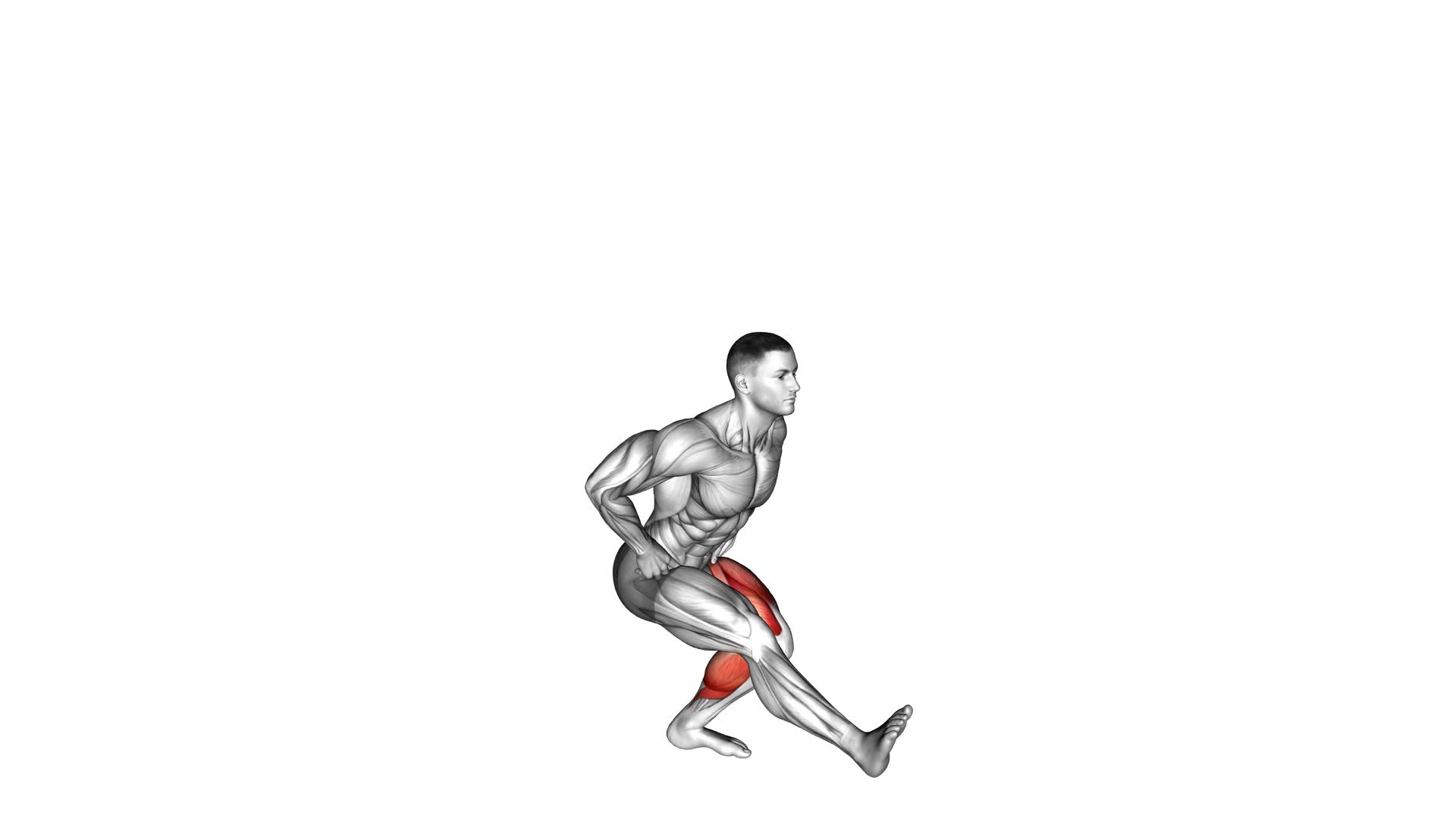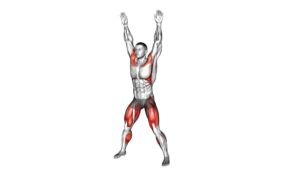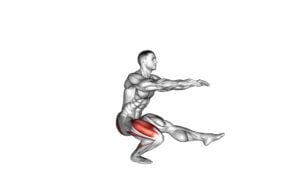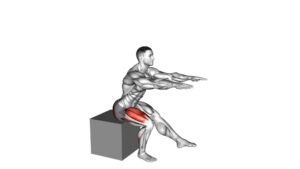Jumping Pistol Squat – Video Exercise Guide & Tips

Looking to take your leg workout to the next level? The jumping pistol squat is here to challenge you.
Watch This Exercise Video
In this video exercise guide, we'll show you the proper form and technique to master this dynamic move.
Whether you're a beginner or advanced, we've got tips to help you maximize the benefits and avoid common mistakes.
Get ready to build strength, improve balance, and level up your fitness routine with the jumping pistol squat.
Let's dive in!
Key Takeaways
- Jumping Pistol Squats improve lower body strength and explosiveness.
- They target quadriceps, hamstrings, glutes, and calf muscles.
- Engaging in Jumping Pistol Squats enhances athletic performance in activities like running and jumping.
- Beginners should focus on developing balance and control before progressing to more advanced variations.
Benefits of Jumping Pistol Squats
Jumping Pistol Squats provide a significant improvement to your lower body strength and explosiveness. Incorporating plyometric training, these squats engage your leg muscles in a dynamic and explosive movement, boosting your leg strength and power.
When you perform Jumping Pistol Squats, you aren't only working on your leg muscles, but also engaging your core for stability and balance. This exercise targets your quadriceps, hamstrings, glutes, and calf muscles, helping to strengthen and tone them. Additionally, the explosive nature of this exercise helps to activate fast-twitch muscle fibers, which are responsible for generating power and speed.
By including Jumping Pistol Squats in your workout routine, you can enhance your athletic performance in activities that require lower body strength and power, such as running, jumping, and sports like basketball and soccer. The explosive nature of these squats also increases your vertical jump and agility, making you more agile and responsive on the field or court.
Proper Form and Technique
To perform the Jumping Pistol Squat with proper form and technique, you'll need to maintain a strong and stable core while executing a dynamic and explosive movement. Here are some key points to keep in mind:
- Maintain balance: Find a focal point to help you stay balanced throughout the movement.
- Control your descent: Lower yourself down slowly and under control, keeping your weight on your heel.
- Engage your glutes: Focus on activating your glute muscles to power the explosive jump.
It is important to address some common misconceptions about the Jumping Pistol Squat. One misconception is that this exercise only targets the legs. In reality, the Jumping Pistol Squat also engages the core, glutes, and hips, making it a great full-body exercise. Additionally, some people may believe that the movement should be rushed, leading to poor form and potential injury. Remember to take your time and focus on maintaining proper form throughout the exercise.
Now that you understand the importance of proper form and technique, let's move on to essential tips for beginners to help you master the Jumping Pistol Squat.
Essential Tips for Beginners
To ensure a successful start with the Jumping Pistol Squat, beginners should focus on developing proper balance and control. This exercise can be challenging, but with the right modifications and warm-up exercises, you can build strength and improve your technique.
For beginners, it's important to start with modified versions of the Jumping Pistol Squat. One modification is to use a support, such as a chair or wall, to assist with balance. This will help you feel more stable as you work on building strength in your legs.
Before attempting the Jumping Pistol Squat, it's crucial to warm up your muscles and joints. Dynamic stretches like leg swings, hip circles, and walking lunges can help prepare your body for the movement. Additionally, performing bodyweight squats and lunges can activate your leg muscles and improve your range of motion.
As you become more comfortable with the basic Pistol Squat, you can progress to more advanced variations and progressions. These may include adding weights, performing the exercise on an unstable surface, or increasing the height of your jump.
By focusing on developing balance and control, modifying the exercise as needed, and warming up properly, beginners can set a solid foundation for their Jumping Pistol Squat journey.
Now, let's explore the exciting world of advanced variations and progressions.
Advanced Variations and Progressions
To advance your Jumping Pistol Squat, try incorporating weighted variations or performing the exercise on an unstable surface. These advanced variations and progressions will take your plyometric training and leg exercises to the next level.
Here are three options to consider:
- Weighted Pistol Squat Jumps: Hold a dumbbell or kettlebell in front of your chest while performing the jumping pistol squat. The added weight will increase the resistance and intensity of the exercise, challenging your muscles even more.
- BOSU Ball Pistol Squat Jumps: Perform the jumping pistol squat on a BOSU ball, which provides an unstable surface. This forces your muscles to work harder to stabilize your body, improving your balance, coordination, and core strength.
- Barbell Pistol Squat Jumps: Hold a barbell across your upper back, similar to a back squat, and perform the jumping pistol squat. The barbell adds significant resistance, making it a more challenging variation for advanced trainees.
Incorporating these advanced variations into your workout routine will help you build explosive power, strength, and stability in your lower body. Remember to start with lighter weights or lower heights and gradually increase the difficulty as you become more comfortable and confident in your abilities.
Keep challenging yourself and enjoy the benefits of these advanced leg exercises.
Common Mistakes to Avoid
Avoid these common mistakes when performing the Jumping Pistol Squat to ensure proper form and maximize the effectiveness of the exercise.
One of the most common mistakes is failing to warm up properly. Before attempting this challenging exercise, it's crucial to warm up your muscles and joints to prevent injuries.
Another mistake isn't maintaining proper alignment. Make sure to keep your knee aligned with your toes and your back straight throughout the movement.
It's also important to avoid rushing through the exercise. Take your time to control the movement and focus on your balance.
Another common mistake is neglecting to engage your core muscles. Your core plays a vital role in stabilizing your body during the Jumping Pistol Squat, so make sure to activate it throughout the exercise.
Lastly, avoid trying to perform the exercise with too much speed or intensity before mastering the proper technique. This can lead to injuries.
Frequently Asked Questions
How Many Calories Can You Burn by Doing Jumping Pistol Squats?
When it comes to burning calories, jumping pistol squats can be more intense than regular pistol squats. By adding a jump, you engage more muscles and increase your heart rate, resulting in a higher calorie burn.
To maximize calorie burn, make sure to maintain proper form throughout the exercise. Bend your supporting leg, lower your body down into a squat, jump explosively, and land softly.
Can Jumping Pistol Squats Help Improve Vertical Jump Height?
Jumping pistol squats can definitely help improve your vertical jump height. By incorporating explosive movements and targeting your leg muscles, these squats can enhance your lower body strength and power.
The benefits of jumping pistol squats include increased leg muscle endurance, improved balance and stability, and enhanced overall athletic performance.
There are also variations of jumping pistol squats, such as adding weights or performing them on an unstable surface, which can further challenge and improve your vertical jump.
Are Jumping Pistol Squats Suitable for People With Knee Injuries?
Jumping pistol squats can be a great exercise for improving your athletic performance, including vertical jump height. However, if you have knee injuries, it's important to modify the exercise to avoid further damage.
There are various variations and modifications for knee injuries that can make jumping pistol squats more suitable for you. These modifications can help reduce strain on the knees while still reaping the benefits of this exercise for your overall athletic performance.
How Often Should I Incorporate Jumping Pistol Squats Into My Workout Routine?
To properly perform jumping pistol squats, start by standing on one leg with your arms extended in front of you.
Slowly lower your body into a squat position, keeping your knee in line with your toes.
Then, explode upwards, jumping off the ground and switching legs mid-air.
Land softly on the opposite leg and repeat.
Incorporating jumping pistol squats into your workout routine can improve lower body strength, balance, and explosiveness.
Can Jumping Pistol Squats Help Increase Overall Leg Strength?
Jumping pistol squats are a great exercise for increasing overall leg strength. By incorporating explosive movements and targeting multiple muscle groups, they can help you build power and stability.
The benefits of jumping pistol squats for athletic performance are immense, as they improve your balance, coordination, and agility.
Additionally, there are variations and progressions of jumping pistol squats available for advanced training, allowing you to continuously challenge and strengthen your legs.
Conclusion
In conclusion, the jumping pistol squat is a challenging exercise that offers numerous benefits. By incorporating explosive movements and strengthening the lower body, it boosts power, agility, and balance.
Proper form and technique are essential to avoid injuries and maximize results. Beginners should start with basic variations and gradually progress to advanced levels. Remember to avoid common mistakes and always listen to your body.
With dedication and consistency, you can master this exercise and achieve impressive fitness gains.

Author
Years ago, the spark of my life’s passion ignited in my mind the moment I stepped into the local gym for the first time. The inaugural bead of perspiration, the initial endeavor, the very first surge of endorphins, and a sense of pride that washed over me post-workout marked the beginning of my deep-seated interest in strength sports, fitness, and sports nutrition. This very curiosity blossomed rapidly into a profound fascination, propelling me to earn a Master’s degree in Physical Education from the Academy of Physical Education in Krakow, followed by a Sports Manager diploma from the Jagiellonian University. My journey of growth led me to gain more specialized qualifications, such as being a certified personal trainer with a focus on sports dietetics, a lifeguard, and an instructor for wellness and corrective gymnastics. Theoretical knowledge paired seamlessly with practical experience, reinforcing my belief that the transformation of individuals under my guidance was also a reflection of my personal growth. This belief holds true even today. Each day, I strive to push the boundaries and explore new realms. These realms gently elevate me to greater heights. The unique combination of passion for my field and the continuous quest for growth fuels my drive to break new ground.







